Since SQL Server does not allow comparison of two columns (e.g., where (store_nbr, item_id)), I am having difficulty comparing the queries, especially when the tables have large amounts of data.
I have 3 tables
I have the below Oracle query
FORCE_TAGS_SQL = """UPDATE /*+ dynamic_sampling(0) index(store_item store_item_pk) */ store_item SET user_bit_5 = '1'
WHERE (store_nbr, item_id) in (SELECT /*+ dynamic_sampling(0) index(tag_demand tag_demand_ix1) */ d.store_nbr, d.item_id
FROM store s, tag_demand d
WHERE s.division_id = 'XYZ'
AND d.store_nbr = s.store_nbr
AND d.print_dt = TRUNC(TO_DATE('2022-04-13', 'YYYY-MM-DD')))
AND user_bit_5 = '0'
"""
and below is the converted SQL Server query
FORCE_TAGS_SQL = """UPDATE STORE_ITEM SET user_bit_5 = '1'
WHERE (store_nbr) in (SELECT d.store_nbr
FROM STORE s, tag_demand d
WHERE s.division_id = 'XYZ'
AND d.store_nbr = s.store_nbr
AND d.print_dt = CONVERT(DATETIME, CONVERT(DATE, '2022-04-13')))
AND (item_id) in (SELECT d.item_id
FROM STORE s, tag_demand d
WHERE s.division_id = 'XYZ'
AND d.store_nbr = s.store_nbr
AND d.print_dt = CONVERT(DATETIME, CONVERT(DATE, '2022-04-13')))
AND user_bit_5 = '0'
"""
Is the SQL Server query same as Oracle query?
Update:
UPDATE store_item SET user_bit_5 = '1'
FROM store_item item INNER JOIN tag_demand d
ON d.store_nbr = item.store_nbr AND d.item_id = item.item_id
WHERE d.store_nbr in ((SELECT s.store_nbr FROM STORE s WHERE s.division_id = 'XYZ')) AND d.print_dt = CONVERT(DATETIME, CONVERT(DATE, '2022-04-13'))
Update#2:
FORCE_TAGS_SQL = """UPDATE STORE_ITEM SET user_bit_5 = '1'
FROM STORE_ITEM
inner join (
SELECT d.store_nbr, d.item_id
FROM store s, tag_demand d
WHERE d.store_nbr = s.store_nbr AND s.division_id = 'XYZ' AND d.print_dt = CONVERT(DATETIME, CONVERT(DATE, '2022-04-13'))
) tagdemand
on tagdemand.store_nbr = STORE_ITEM.store_nbr
AND tagdemand.item_id = STORE_ITEM.item_id
where user_bit_5 = '0'
"""
Update#3
FORCE_TAGS_SQL = """UPDATE STORE_ITEM SET user_bit_5 = '1'
FROM STORE_ITEM
INNER JOIN tag_demand
ON
STORE_ITEM.item_id = tag_demand.item_id
AND STORE_ITEM.store_nbr = tag_demand.store_nbr
AND tag_demand.print_dt = '2022-04-11'
AND tag_demand.STORE_NBR in (SELECT store_nbr FROM store WHERE division_id = 'XYZ')
where user_bit_5 = '0'
"""


